First of all, I need to explain to you what is a light plotter, what is the role of the light plotter, what kind of role it plays in the process of circuit board manufacturers, and what is our circuit board factory's view of the light plotter?

The light painting resolution refers to how many dots can be emitted in one inch length, the unit is: PDI; the optical density refers to the amount of silver particles restored in the emulsion film, that is, the light blocking ability, the unit is "D", the formula: D=lg (incident light energy/transmitted light energy); Gamma: Gamma refers to the degree to which the optical density changes when the film is exposed to light of different intensities and washed according to the standard processing process!
Circuit board factory takes you to understand the knowledge of light plotter
So what are the ingredients and functions of the light painting film produced by the circuit board factory?
surface layer
It plays a role in preventing scratches and protects the silver salt emulsion layer from being damaged!
2. Drug film (silver salt emulsion layer)
The main components of the image layer and emulsion are silver bromide, silver chloride, silver iodide and other silver salt photosensitive materials, as well as gelatin and pigments that can restore the silver core center under the action of light. However, the silver salt is insoluble in water, so gelatin is used to make it into a suspended state and coated on the film base. The pigment in the emulsion acts as a sensitizer.
3. Adhesive layer
Promote the adhesion of the emulsion layer to the film base. In order to improve the bonding force between the emulsion and the film base, an aqueous solution of gelatin and chrome alum is used as the bonding layer to make it firmly bonded.
4. Polyester base layer
Carrier film base and negative film base generally use nitrocellulose, acetate or polyester film base. The first two kinds of film bases have great flexibility, the size of the polyester film base is relatively stable, and the polyester base layer is also an insulating material of our circuit board factory.
5. Anti-halo/static layer
Anti-halation and static electricity. Under normal circumstances, the bottom surface of the photographic film base will reflect light, causing the emulsion layer to be exposed again to produce halo. In order to prevent halo, an aqueous solution of gelatin plus basic fuchsin is used to coat the back of the film base to absorb light. It is called the anti-halation layer.
From the perspective of circuit board manufacturers, what is the evaluation of light-painted negatives?
Optical density of the film
It can be detected by an optical density measuring instrument. Generally, the light blocking area should be greater than 4.0D; the light transmission area should be less than 0.15D.
2. Contrast contrast
It is necessary to choose a negative with a large contrast coefficient to make a working negative with better contrast, otherwise the optical density will be difficult to achieve, even if you lengthen the development time to make the optical density meet the requirements, it will bring you fog Aggravate.
3. Line edge gradient
That is to say whether it is black and white, and whether the line edge is sharp!
4. With or without trachoma
Some negatives are prone to blisters if the light intensity is not well adjusted.